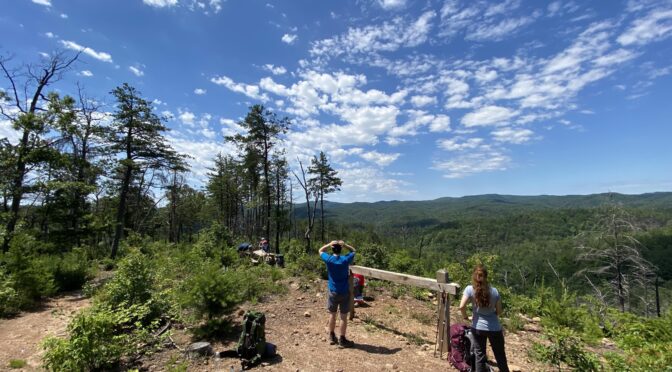This weekend, we were able to conclude our Spring GetBackpacking! Intro to Backpacking class, with a graduation weekend at South Mountains State Park. Originally scheduled for the end of March, this pandemic-delayed trip was one we were especially interested in, as a way to gauge whether we might be able offer small-batch backpacking trips. In short, could we enforce physical distancing to the point we would feel safe moving ahead.
There were two behaviors in particular that we need to be comfortable with:
- Wearing masks: at the trailhead, as we gathered to set out; on the trail as we passed other hikers on narrow trail; in camp settings where it was hard to stay apart.
- Keeping six feet apart at all times.
Wearing masks
Every backpacker showed up at the trailhead wearing a mask, for which we were encouraged. No complaints, no whining. Once we hit the trail, we removed our masks.
Donning our masks as we passed other hikers was a non-issue. The 40 miles of trail at South Mountains are nearly all double track — extra wide trails that easily accommodate a six-foot buffer between hikers. This was especially good because we were able to hike two abreast, with plenty of distancing, allowing for easy conversation. As for passing other hikers, at South Mountains, 90 percent of the visitors only make the mile-long pilgrimage to High Shoals Falls; elsewhere, you might see the occasional runner or mountain biker, more likely some folks on horseback. Encountering others wasn’t a problem.
Six feet of separation
More of a challenge was consistently maintaining that six-foot buffer. Curiously, we had the most evenly-paced hikers we’ve every had. Typically, with backpacking — and with group hiking as well — the group tends to spread out. Some folks love a good aerobic workout, some like to stop and smell the multiflora roses. The first backpacker may get to camp an hour and a half before the last. This weekend’s group hiked in lockstep. Subtly, we managed to spread them out when they bunched up.
It was encouraging that everyone understood why we had these distancing requirements; they felt that being in the woods was well worth this small price. It’s this attitude, this understanding, that will drive our decisions moving forward. There’s a lot that remains to be learned about the novel coronavirus. But within the medical community there does seem to be agreement that the odds of transmission diminish significantly when we keep our distance from one another, and when we can’t, that we wear masks. (We’re going with the ultimate authority on things communicable, by the way: the Centers for Disease Control and Prevention, which makes its case for masks and social distancing here.)
That’s a pretty easy protocol to follow hiking.
Hiking: the near future
Later this week we will unveil our hike and backpack agenda into September. It will be subject to change, based on what our local government leaders deem is in the public interest. Factors that we will take into consideration include:
Avoiding popular spots. Since the beginning, GetHiking! and GetBackpacking! have emphasized the trails less traveled. Sure, we hike the places others love to hike: the Appalachian Trail (especially at Carvers Gap and Max Patch), along the Blue Ridge Parkway, and in our State Parks. But increasingly, as State Parks are forced to close their gates when they reach capacity (sometimes within an hour or two of opening), we’ve been looking at the places most folks aren’t familiar with. Expect to see more lesser-known destinations.
- More hikes/trips on wider trails. Save for the popular one-mile trek to High Shoals Falls, South Mountains, with it’s network of wide trails, is ideal hiking and backpacking in these viral times. Another option we’ve been exploring: N.C. Wildlife Commission game lands, which are navigated primarily via gravel roads closed to traffic. A good option for summer, since there’s no hunting.
- More hikes/trips on remote trails. With hundreds of miles of trail in the Pisgah and Nantahala national forests. more remote trails can be found, especially in wilderness areas.
- More hikes at off times. More hikes at night, more hikes first thing in the morning, more hikes during the week.
- Smaller group sizes. Depending upon the trail, we’re looking at backpack trips in the 6- to 8-person range, and day hikes with no more than 10.
Physically distancing can be a challenge, even for the most well-intentioned.
As Guide Alison Watta, who lead the weekend’s South Mountains trip, notes, “There is a likelihood someone may get closer than six feet accidentally. If this concerns someone, then they either aren’t ready for the trip, or I would recommend they be in the back where they can more readily control their environment.”
We’ll be back Friday with our plan.
